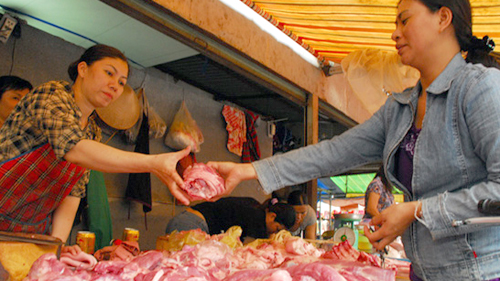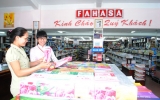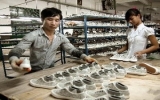Poor forecasts create difficulties for livestock breeders
Many livestock breeders in Vietnam have suffered great losses due to price fluctuations and ineffective market forecasting.
The National Institute of Animal Husbandry (NIAH) Pig Research Centre reported that purchases of specific pig varieties decreased 70 percent in the first quarter of 2013 compared to the previous year, and there is still an inventory of more than 10,000 piglets, which presents difficulties for breeders because of capital shortages.Pork prices are falling dramatically, averaging around
VND37,000 per kilo, and farmers face an estimated loss of VND10,000/kg. Prices
of chickens have also dropped by VND10,000-12,000/kg and are now lower than
market prices in China and Thailand. 
Le The Tuan, Director of the NIAH Centre for Pig Research, said the livestock industry has encountered numerous challenges since 2012 due to negative impacts from the economic downturn, as well as some pig breeders using banned drugs to produce leaner meat.
In addition, he said, epidemics of pig diseases are still prevalent in many localities, which has a significant effect on domestic pork consumption.
China, a large pork importer, sometimes bans the importation of Vietnamese pigs, which also causes strong price fluctuations and an imbalance of supply and demand.
Tuan attributed the unstable pork market to a lack of a sustainable zoning the animal breeding sector.
In Vietnam, only25 percent are produced by large-scale breeding farms with processing facilities while up to 75 percent of pigs and poultry are raised by individual households .At present, Vietnam only exports pork to China, and has not yet penetrated other high-demand markets like Japan and Europe.
Professor Dr. Nguyen Dang Vang, Chairman of the Vietnam Animal Breeding Association, admitted that both farmers and relevant agencies have been very passive regarding forecasting and the current market solutions are not practical.
Reports are only made based on facts and figures from the General Statistics Office (GSO). However, most of these statistics are based on local reports, not scientific research or general surveys. As a result, the present forecasts and solutions fail to meet the necessary requirements for livestock breeders.
Local farmers need accurate market forecasts with updated information on current prices and demand, Vang noted.
He argues that farmers’ losses can be partially attributed to weak, inefficient forecasting. Proper, accurate forecasts are essential to boost the capacity of the Vietnamese livestock industry, he added.
Vietnam’s animal breeding sector is predicted to face huge challenges in 2015 as the Association of Southeast Asian Nations (ASEAN) will establish a common market and remove all tariff barriers
Many foreign businesses’ greater involvement in the Vietnamese livestock market in the future will create fierce competition for local farmers and businesses.
VOV Bau Bang district Association of Women coordinates to introduce and connect OCOP
Bau Bang district Association of Women coordinates to introduce and connect OCOP
 Towards sustainable economy
Towards sustainable economy
 Provincial Trade Union supports VND53billion, 100 tons of goods for flood and storm-hit people
Provincial Trade Union supports VND53billion, 100 tons of goods for flood and storm-hit people
 Supporting enterprises in promoting automation
Supporting enterprises in promoting automation
 New motivation for Thuan An city to develop
New motivation for Thuan An city to develop
 Taking advantage of new opportunities in investment attraction
Taking advantage of new opportunities in investment attraction
 Training course on labor hygiene and safety opens to tens of enterprises
Training course on labor hygiene and safety opens to tens of enterprises
 The defense of trade in Binh Duong to assist enterprises downturning challenges
The defense of trade in Binh Duong to assist enterprises downturning challenges
 Ben Cat City focuses efforts to complete targets and plans for 2024
Ben Cat City focuses efforts to complete targets and plans for 2024
 Food safety during 2024 Mid-Autumn Festival
Food safety during 2024 Mid-Autumn Festival











